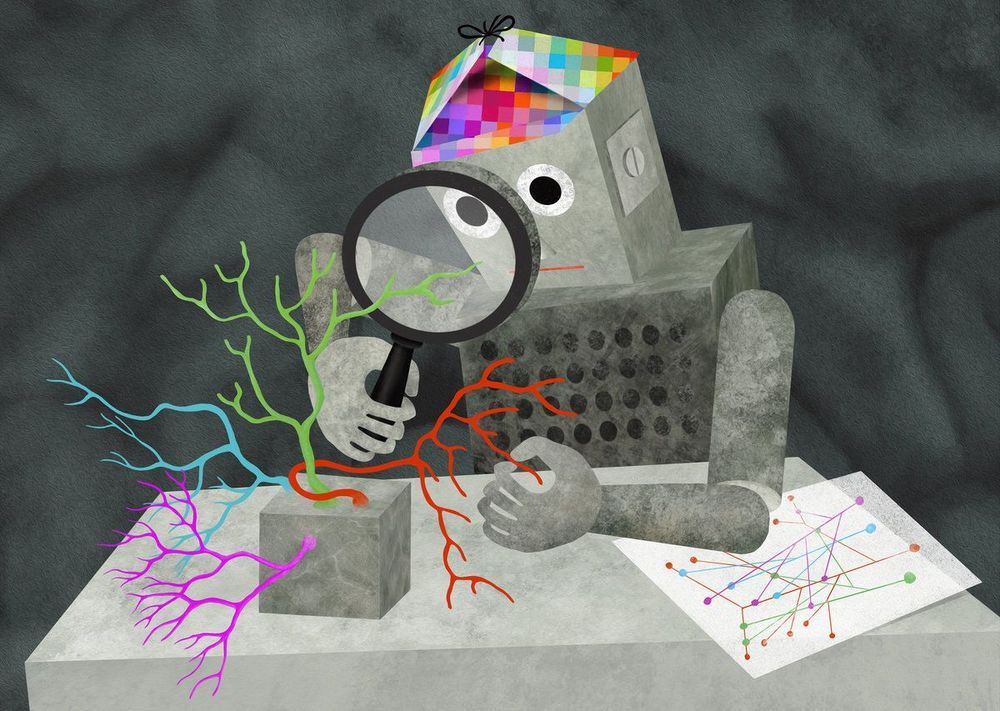Page 8622
Jun 22, 2019
Conscious Brain-to-Brain Communication in Humans Using Non-Invasive Technologies
Posted by Richard Christophr Saragoza in categories: biotech/medical, computing, internet, neuroscience
Human sensory and motor systems provide the natural means for the exchange of information between individuals, and, hence, the basis for human civilization. The recent development of brain-computer interfaces (BCI) has provided an important element for the creation of brain-to-brain communication systems, and precise brain stimulation techniques are now available for the realization of non-invasive computer-brain interfaces (CBI). These technologies, BCI and CBI, can be combined to realize the vision of non-invasive, computer-mediated brain-to-brain (B2B) communication between subjects (hyperinteraction). Here we demonstrate the conscious transmission of information between human brains through the intact scalp and without intervention of motor or peripheral sensory systems. Pseudo-random binary streams encoding words were transmitted between the minds of emitter and receiver subjects separated by great distances, representing the realization of the first human brain-to-brain interface. In a series of experiments, we established internet-mediated B2B communication by combining a BCI based on voluntary motor imagery-controlled electroencephalographic (EEG) changes with a CBI inducing the conscious perception of phosphenes (light flashes) through neuronavigated, robotized transcranial magnetic stimulation (TMS), with special care taken to block sensory (tactile, visual or auditory) cues. Our results provide a critical proof-of-principle demonstration for the development of conscious B2B communication technologies. More fully developed, related implementations will open new research venues in cognitive, social and clinical neuroscience and the scientific study of consciousness. We envision that hyperinteraction technologies will eventually have a profound impact on the social structure of our civilization and raise important ethical issues.
Citation: Grau C, Ginhoux R, Riera A, Nguyen TL, Chauvat H, Berg M, et al. (2014) Conscious Brain-to-Brain Communication in Humans Using Non-Invasive Technologies. PLoS ONE 9: e105225. https://doi.org/10.1371/journal.pone.
Editor: Mikhail A. Lebedev, Duke University, United States of America.
Jun 22, 2019
‘Mind-Reading’ AI Turns Thoughts Into Spoken Words
Posted by Richard Christophr Saragoza in categories: biotech/medical, robotics/AI
Always think positively!
“Our voices help connect us to our friends, family and the world around us, which is why losing the power of one’s voice due to injury or disease is so devastating. This could happen due to various reasons such as ALS [amyotrophic lateral sclerosis] or stroke,” resulting in what is known as “locked-in-syndrome,” he added.
“Our ultimate goal is to develop technologies that can decode the internal voice of a patient who is unable to speak,” said Mesgarani.
Continue reading “‘Mind-Reading’ AI Turns Thoughts Into Spoken Words” »
Jun 22, 2019
What Happens When Scientists Experiment on Themselves?
Posted by Paul Battista in category: biotech/medical
Cross a compulsive need to discover the truth with a strong sense of adventure, and watch modern medicine move forward.
Jun 22, 2019
SpaceX is about to launch 152 dead people’s remains into orbit aboard a Falcon Heavy rocket
Posted by Alberto Lao in category: space travel
A company called Celestis has tucked small pods of cremated “participants” into a spacecraft that will also carry NASA’s Deep Space Atomic Clock.

🤯 AWESOME! NASA has just released a 4K video tour of Earth’s moon and the footage will make your jaw drop. Credit: NASA (You can also read about this here: https://www.realitybeyondmatter.com/2018/07/nasa-releases-4k…Wydp6i5AjE)
Jun 22, 2019
Helaman Ferguson, Sculptor
Posted by Richard Christophr Saragoza in category: materials
Dimensions: 3.5″ x 3.0″ x 1.8″ Date: 1993 Material: original stone is virginia albamarle serpentine, reproductions silicon bronze Special Engraving: the matrix (0,1 | 1,1) Weight: 4 oz Copyright Notice: © 1993 Copyright Registered: 1996.
The Fibonacci numbers are ubiquitious in nature and mathematics. This palmsize sculpture encapsulates the generating matrix for these numbers. In a problem published 800 years ago, Leonardo of Pisa, a.k.a. Fibonacci formulated his famous rabbit problem: beginning with a newborn fertile pair of rabbits, how many pairs will accumulate monthly if each pair produces another pair from their second month on? The solution of this leads to a recursively defined sequence of integers, 0, 1, 1, 2, 3, 5, 8, 13, 21, 34, 55, 89, 144, … This sequence has the property that two consequtive terms added give the next term.
The Fibonacci Matrix Torus has raised (esker) curves or continuous crests which wind around the torus either the short way or both the short and long way. This gives the matrix with first row (0, 1) and second row (1, 1) respectively. The powers of this matrix give matrices whose entries are always Fibonacci numbers.
Jun 22, 2019
Florida town pays $600,000 virus ransom
Posted by Fyodor Rouge in categories: biotech/medical, computing
Computers for Riviera Beach have been locked up for more than three weeks following the attack.
Jun 22, 2019
Artificial intelligence learns to recognize nerve cells
Posted by Paul Battista in categories: mapping, robotics/AI
Is it possible to understand the brain? Science is still far from answering this question. However, since researchers have started training artificial intelligence on neurobiological analyses, it seems at least possible to reconstruct the cellular structure of a brain. New artificial neural networks developed by the Max Planck Institute of Neurobiology and Google AI can now even recognize and classify nerve cells independently based on their appearance.
The human brain consists of about 86 billion nerve cells and about as many glial cells. In addition, there are about 100 trillion connections between the nerve cells alone. While mapping all the connections of a human brain remains out of reach, scientists have started to address the problem on a smaller scale. Through the development of serial block-face scanning electron microscopy, all cells and connections of a particular brain area can now be automatically surveyed and displayed in a three-dimensional image.
“It can take several months to survey a 0.3 mm piece of brain under an electron microscope,” says Philipp Schubert, doctoral student in Winfried Denk’s Department at the Max Planck Institute of Neurobiology. “Depending on the size of the brain, this seems like a lot of time for a tiny piece. But even this contains thousands of cells.” Such a data set would also require almost 100 terabytes of storage space. However, it is not the collection and storage but rather the data analysis that is the difficult part.
















